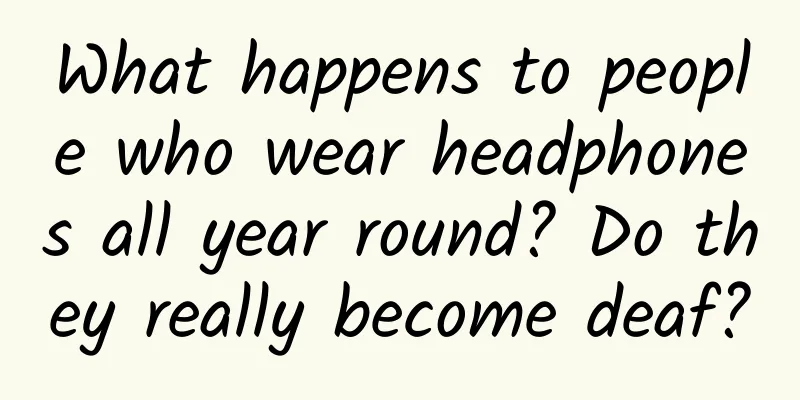What happens to people who wear headphones all year round? Do they really become deaf?

|
For many people, headphones must be an indispensable part of life. Morning jog, subway, TV series, games, office... As long as you put on headphones, you can immerse yourself in your own world without being disturbed by the outside world. Some people even wear headphones when sleeping. But is it really okay to wear headphones for a long time? The dangers of improper use of headphones The World Hearing Report released by the World Health Organization in 2021 shows that about 1.1 billion young people around the world are facing a huge risk of permanent hearing loss due to listening to loud music for a long time, and about 200 million of them are also suffering from chronic ear infections. The harm of improper long-term use of headphones is mainly reflected in two aspects: 1. High-intensity sound stimulation may damage the auditory system and cause hearing loss. 2. Wearing headphones for a long time may increase the risk of infection of the auricle and external auditory canal. 1 Hearing loss Our ears are mainly composed of four parts: the auricle, the external auditory canal, the middle ear, and the inner ear. Sound enters the inner ear through two pathways: air conduction and skull bone conduction. Air conduction is the main pathway, where the sound is collected by the auricle and transmitted to the eardrum through the external auditory canal, causing the eardrum to vibrate. This vibration drives the ossicular chain in the middle ear to move, and the vibration of the stapes footplate of the ossicular chain is transmitted to the cochlear hair cells in the inner ear through the vestibular window, converting the sound signal into an electrical signal, which is then transmitted to the brain through the auditory nerve, and we can hear the sound. However, long-term use of headphones and continuous sound stimulation to the ears, especially when the volume is too high, may cause damage to the cochlear hair cells, leading to noise-induced hearing loss or tinnitus. Copyright images in the gallery. Reprinting and using them may lead to copyright disputes. 2 Induce ear diseases Ear canal furunculosis: The earphones we use daily are mostly in direct contact with the front of the auricle and the cartilage of the external auditory canal. Frequent use of earphones may cause repeated pressure and irritation to the skin in these areas, leading to skin damage, pain or itching, and increasing the chance of furunculosis. Otitis externa: Wearing headphones for a long time can cause poor air circulation in the external auditory canal, increase humidity, and facilitate the growth and reproduction of bacteria and fungi. In addition, the earplugs of some headphones are made of materials such as silicone, which may cause allergies, skin redness, swelling and itching. At the same time, if the headphones are not cleaned regularly after long-term use, bacteria and dirt may accumulate. When the headphones come into contact with the ear canal, these pathogens may enter the ear canal and cause otitis externa. If headphones are used cross-wise, the risk of spreading pathogens will also increase. Earwax blockage: Long-term wearing of in-ear headphones will not only affect the normal discharge of earwax, but also stimulate the cerumen glands in the external auditory canal to increase secretion and condense into lumps. In addition, improper handling methods, such as using cotton swabs to clean the ear canal, may push earwax deeper into the ear canal, causing earwax blockage, which in turn causes discomfort and infection in the external auditory canal. It is especially important to note that because we are in a noisy environment, in order to obtain clear and good sound effects, we often unconsciously turn up the volume of the headphones. However, when the sound intensity reaches more than 80 decibels and the cumulative duration exceeds 40 hours per week, it will damage the fragile hair cells in our inner ear, leading to hearing loss. Long-term exposure to high-decibel sound environments not only causes direct ear problems such as tinnitus and hearing loss, but may also lead to a series of other noise-related health risks, including ischemic heart disease, hypertension, sleep disorders, emotional distress, and cognitive impairment. These seemingly unrelated health problems are actually inextricably linked to long-term noise exposure. How to use headphones correctly 1 Control headphone usage time and volume In order to protect hearing, the "60-60" principle should be followed, that is, adults should not use headphones for more than 60 minutes at a time, and the volume should not exceed 60% of the maximum volume; 2 Pay attention to the cleaning of the headphones Develop the habit of cleaning your headphones regularly to prevent bacteria and fungi from growing and reduce the risk of infection; 3 Choose the right type of headphones Choosing high-quality headphones or headphones with good noise reduction can effectively improve sound quality and reduce interference from external environmental noise; 4 Choose the environment in which to use the headset Avoid using headphones in noisy environments, such as on the subway, on the bus, or on the roadside. If necessary, give priority to active noise-cancelling headphones. Do not turn up the volume too high in order to hear the sound in the headphones clearly. Try to control the volume to the minimum level that allows you to hear the content clearly. 5 It is not suitable to wear headphones when sleeping Wearing headphones while sleeping increases the risk of damage to the ear structure, which in turn causes external ear infection; at the same time, wearing headphones while sleeping will not only cause the inner ear hair cells to continue to receive stimulation from sound signals, leading to hearing fatigue and ultimately causing noise-induced hearing damage, but also the continuous sound stimulation will cause the brain to enter a shallow sleep state, affecting sleep efficiency and causing a worse mental state the next day. Headphones are our life companions, but they can also be invisible killers of hearing. Only by using headphones properly and protecting hearing can we enjoy the wonderful sounds of the world. References [1] Huang Xuanzhao, Wang Jibao, Kong Weijia. Practical Otorhinolaryngology Head and Neck Surgery 2nd Edition [M]. Beijing: People's Medical Publishing House, 2008. [2]World Health Organization. Environmental noise guidelines for the European region. 2018. [3]World Health Organization. World report on hearing[R/OL]. Geneva: WHO, 2021. https://www.who.int/publications/i/item/9789240020481 [4]Chadha S, Kamenov K. Regulation for control of sounds exposure in entertainment venues. World Health Organization; 2019. [5]Le TN, Straatman LV, Lea J, Westerberg B. Current insights in noise-induced hearing loss: a literature review of the underlying mechanism, pathophysiology, asymmetry, and management options. J Otolaryngol Head Neck Surg. 2017;46(1):41. [6]World Health Organization. Regional Office for Europe. Burden of disease from environmental noise: quantification of healthy life years lost in Europe. 2011. https://apps.who.int/iris/handle/10665/326424 [7]World Health Organization. Regional Office for Europe. Environmental noise guidelines for the European Region. 2018. https://www.euro.who.int/__data/assets/ pdf_file/0008/383921/noise-guidelines-eng.pdf , Planning and production Author: Yang Jianwang Department of Otolaryngology and Head and Neck Surgery, The Second Hospital of Hebei Medical University Review | Pan Chunchen, deputy chief physician of the Department of Otolaryngology, The First Affiliated Hospital of University of Science and Technology of China Planning丨Fu Sijia Editor: Fu Sijia Proofread by Xu Lailinlin |
>>: Plants: If I don’t catch the “mutation”, I will be the “lamb to be slaughtered”…
Recommend
How can operations learn from user feedback and avoid detours?
Learning from user feedback is a big or small thi...
What are the Google SEO optimization techniques? Does Google SEO promotion really work?
Most domestic companies basically have their own ...
How to place e-commerce advertisements for TikTok overseas promotion?
In 2020, when the epidemic suddenly spread across...
China Charging Alliance: Operation status of national electric vehicle charging and swapping infrastructure in February 2022
National Electric Vehicle Charging and Replacemen...
Why is it that your article is very good, but users have no desire to pay attention to it?
Recently, a reader who runs a public account aske...
AMD's 15cm R9 Nano graphics card also suffers from "electrical whistling"
AMD recently officially launched the Radeon R9 Na...
What are the methods and techniques for online promotion?
Internet promotion is to publicize and promote pr...
Insights: True self-discipline is to be responsible for your own life
Famous Artists Gallery | Chen Banding, also known...
"National Treasure" 212: A gorgeous transformation from a model to a brand, ready to return to the market
Recently, what has excited off-road vehicle enthu...
Toyota provides Tokyo with hydrogen fuel cell buses that can be used as generators in emergencies
Foreign media reports Toyota recently said it wou...
The Economist: The age of drones has arrived
The Economist website reported that the scale and...
Douyin private domain solution and four core capabilities
01 Positioning and value of Douyin private domain...
Is it better to use a second-level domain name or a second-level directory for a website?
For a large website, if you want to expand the sc...
The Open Source Management Guide: Four Ways to Successfully Open Up Your Project Infrastructure
【51CTO.com Quick Translation】Open source means mo...
Need IV drips every time you get sick? These diseases don’t require it!
For a long time, people have believed that intrav...

![Blue Maple Graphic Game Visual 2021 PS Tutorial [HD Quality with Materials]](/upload/images/67cc065aefc93.webp)







